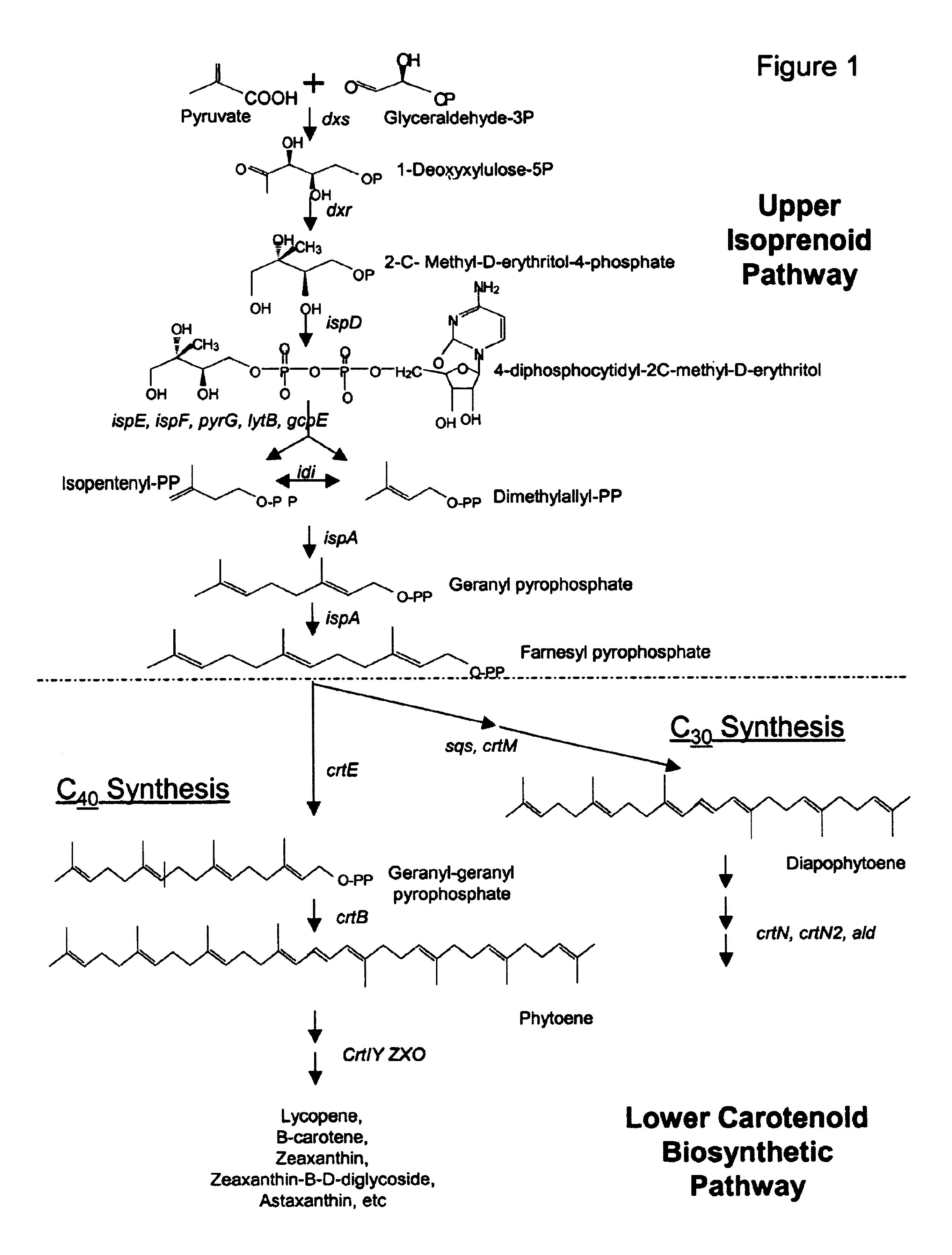Genes encoding carotenoid compounds
a carotenoid compound and gene technology, applied in the field of molecular biology and microbiology, can solve the problems of high cost of carotenoids produced from these plants, low carotenoid synthesis productivity, and difficult chemical production of compounds
- Summary
- Abstract
- Description
- Claims
- Application Information
AI Technical Summary
Benefits of technology
Problems solved by technology
Method used
Image
Examples
example 1
Isolation of a Carotenoid-Producing Pectobacterium cypripedii
[0231]The present Example describes the isolation and identification of a yellow-pigmented bacterium, presently classified as Pectobacterium cypripedii strain DC416. Analysis of the native carotenoids produced in this organism confirms production of zeaxanthin, in addition to various zeaxanthin precursors and zeaxanthin derivatives.
[0232]Strain isolation and 16S rRNA typing: To isolate novel carotenoid producing bacterial strains, pigmented microbes were isolated from a collection of environmental samples. Thus, one yellow strain (named as “strain DC416”) was isolated from a Florida tree bark. The tree bark piece was resuspended in LB broth and cells in the suspension were streaked on LB plates. A yellow colony was picked and purified by streaking twice on LB plates.
[0233]Strain DC416 was typed by 16S rRNA gene sequencing. Specifically, the 16S rRNA gene of the strain was amplified by PCR using primers HK12 (SEQ ID NO:13)...
example 2
Identification of Pigmented Cosmid Clones of Pectobacterium cypripedii
[0242]Example 2 describes the construction of an E. coli cosmid clone capable of expressing an ˜40 kB fragment of genomic DNA from P. cypripedii DC416. This transformant produced zeaxanthin, in addition to various zeaxanthin precursors and zeaxanthin derivatives.
[0243]Chromosomal DNA Preparation: Pectobacterium cypripedii DC416 was grown in 25 mL LB medium at 30° C. overnight with aeration. Bacterial cells were centrifuged at 4,000 g for 10 min. The cell pellet was gently resuspended in 5 mL of 50 mM Tris-10 mM EDTA (pH 8) and lysozyme was added to a final concentration of 2 mg / mL. The suspension was incubated at 37° C. for 1 h. Sodium dodecyl sulfate was then added to a final concentration of 1% and proteinase K was added at 100 μg / mL. The suspension was incubated at 55° C. for 2 h. The suspension became clear and the clear lysate was extracted twice with an equal volume of phenol:chloroform:isoamyl alcohol (25:...
example 3
Identification of Carotenoid Biosynthesis Genes
[0246]This Example describes the identification of P. cypripedii DC416 crtE, crtX, crtY, crtI, crtB, and crtZ genes in cosmid pWEB-416, and provides a comparison of the relatedness of these genes with respect to other known Panteoa crt genes.
[0247]HPLC analysis suggested that cosmid pWEB-416 should contain genes for synthesis of zeaxanthin and its derivatives. To sequence the carotenoid synthesis genes, cosmid DNA pWEB-416 was subjected to in vitro transposition using the EZ::TN kit from Epicentre (Madison, Wis.) following the manufacturer's instructions. Two hundred tetracycline resistant transposon insertions were sequenced from the end of the transposon using the TET-1 FP-1 Forward primer (SEQ ID:17). Sequence assembly was performed with the Sequencher program (Gene Codes Corp., Ann Arbor, Mich.). A 8675 bp contig (SEQ ID:18) containing carotenoid synthesis genes from DC416 was assembled (FIG. 5).
[0248]Genes encoding crtE, crtX, crt...
PUM
| Property | Measurement | Unit |
|---|---|---|
| Fraction | aaaaa | aaaaa |
Abstract
Description
Claims
Application Information
 Login to View More
Login to View More - R&D
- Intellectual Property
- Life Sciences
- Materials
- Tech Scout
- Unparalleled Data Quality
- Higher Quality Content
- 60% Fewer Hallucinations
Browse by: Latest US Patents, China's latest patents, Technical Efficacy Thesaurus, Application Domain, Technology Topic, Popular Technical Reports.
© 2025 PatSnap. All rights reserved.Legal|Privacy policy|Modern Slavery Act Transparency Statement|Sitemap|About US| Contact US: help@patsnap.com



